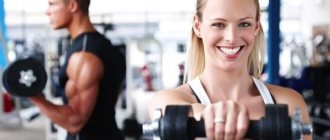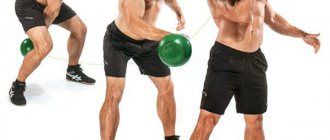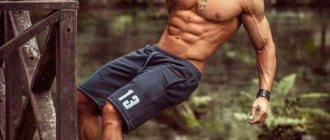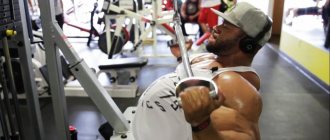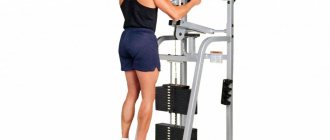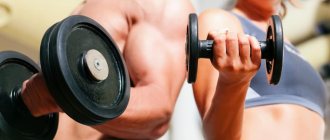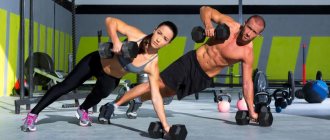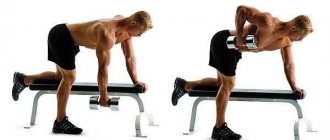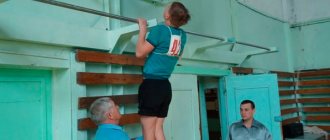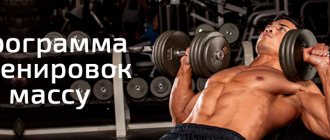| Emblem of the Kettlebell Lifting Federation |
| Weight-lifting |
|
| Theory |
|
| Inventory |
|
| Training |
|
| Competitive exercises |
|
| Preparatory exercises |
|
| Nutrition and recovery |
|
What muscles are involved?
The deadlift with one kettlebell is practically no different from the classic version. It is also a basic exercise, the only difference being that the weight used here is not sufficient for active muscle growth.
It involves the following muscle groups:
- The main load will be taken by the back extensors. They are responsible for straightening the body and stabilizing its position.
- The legs, especially the buttocks and hamstrings, also make a significant contribution to the movement. They help to straighten the body and return it to its normal position. The quadriceps are also involved in the movement - they provide explosive force when straightening the knees from the bottom point.
- The arms and back receive a static load, holding the weight and preventing it from moving in space.
- In addition, the core muscles, as well as many other small muscle groups, play the role of stabilizers, helping to maintain balance and correct body position.
The double kettlebell deadlift combines the movements of the deadlift and the t-bar row, with the positive attributes of both.
With its help they develop:
- Muscles of the back and lumbar region - they are necessary to return the body to a vertical position.
- The buttock and hamstrings will receive more load in the double kettlebell version, since the exercise is performed on one leg, and, accordingly, they will require more effort to return the body to the correct position.
- While holding a horizontal position on one leg, the muscle groups of the lumbar region, abs and core, as well as the quadriceps, receive an impressive static load, even despite the use of light weight.
- To maintain this position, a huge number of small muscles are used as stabilizers. You yourself can feel how unstable your body position will be. The more often this option is practiced, the stronger the muscles responsible for balance will become.
- Holding weights in free-hanging arms strains and stretches the muscles of the arms, chest, and latissimus dorsi.
Basic leg exercises
Let's first talk about basic leg exercises. After all, many ignore this muscle group, but in vain.
Squats
Barbell squats are one of the fundamental exercises in many sports. In this movement, almost all muscle groups of your body work in one way or another. The main dynamic load falls on the quadriceps, hamstrings, spinal extensors, gluteal muscles and hip adductors. When working with serious weight, a significant static load falls on the abdominal muscles, shoulders and trapezius muscles.
Vitaly Sova — stock.adobe.com
A clear position of the head helps stabilize the movement - the gaze should be directed strictly in front of you or slightly upward, this will make it psychologically easier for you to get up from a lower position.
Don't forget about the position of your feet - in general, they should be placed slightly wider than your shoulders, with your toes pointing to the sides. When rising from a squat, never bring your knees together.
This also includes squats in Smith and hack machine. These movements are a little simpler in terms of technique. The general principle is the same, but the position of the body and the projectile is more fixed, which is why fewer stabilizer muscles are involved in the work.
mountaira - stock.adobe.com
Leg press
The platform leg press cannot fully replace heavy squats with a barbell, but the load on the legs is no less: the front, back and inner thighs and gluteal muscles work. Perfect for beginners for whom the squat technique will be too difficult at the initial stage.
The most important thing in this exercise is not to overdo it with the working weight. This will make it more difficult for you to control the correct position of your knees. If you bring them inside the trajectory of movement, you risk injury to the ligaments.
It is also important to work in a comfortable amplitude. Do not try to lower the platform as low as possible
The geometry of most exercise machines is designed in such a way that at the lowest point your spine will be rounded in the tailbone area. This is an extremely traumatic position. At the top point, you don’t need to straighten your knees all the way, leave them slightly bent.
Lunges
You can perform lunges with your own weight, with a barbell or dumbbells. In any variation, you will use all areas of the leg muscles. Depending on the width of the step, the direction of movement and the position of the foot, you can slightly emphasize the load on one or another area: with a shorter step, the emphasis falls on the quadriceps, with a wide one, on the hamstrings.
If you perform a step in such a way that at the bottom point the angle between the shin and the thigh of both legs is 90 degrees, the load is equally distributed on the front and back surfaces of the thigh.
Sumo deadlift
This is a variation of the classic deadlift, in which the emphasis shifts to the legs (adductors, quadriceps and hamstrings) and works the back to a lesser extent. This is achieved through wider stance of the legs. The range of motion in a sumo stance is a little shorter, but this does not eliminate the powerful static tension in the abdominal muscles, back, trapezius and arms.
The correct technique for performing a sumo deadlift involves a deep squat in the starting position and maintaining a straight back throughout the entire exercise. This way you minimize the risk of back injury or umbilical hernia.
Athletes who are not involved in powerlifting should avoid using an underhand grip, as it can also lead to spinal injury. Use a regular overhand grip; you can attach straps if the weight is too heavy.
Romanian deadlift
It is often mistakenly called a deadlift, although in fact a deadlift is a regular classic deadlift. In the Romanian version, the legs remain slightly bent throughout the entire approach; the work is mainly carried out by the extensors of the spine and biceps of the thigh. That is why this exercise can be considered a basic one for the back. It’s also a good idea to include the gluteal and other additional stabilizers (trapezius, calf, etc.).
There is no need to perform this movement with fully straightened legs, as this can cause injury. The angle of the knees should not change throughout the entire approach. The bend should be done to a comfortable point, stretching is different for everyone, it should not be done through pain
It is also important not to hunch your back; if you can’t do this, reduce the working weight
Another version of this exercise is with dumbbells, the technique here is identical, but the emphasis shifts more to the gluteal muscles.
Pros and cons of the exercise
The single kettlebell deadlift is used because it is the same basic exercise as the classic deadlift. This option has the following advantages:
- It uses many joints throughout the body, which stimulates the body to increase testosterone production.
- Speeds up metabolism and triggers anabolic processes throughout the body.
- The shifted center of gravity partly transfers loads to the forearms and palm extensors. Thanks to this, this type of deadlift can strengthen and strengthen your grip much more effectively than other exercises.
- Improves coordination of movements and develops qualities necessary where jerking efforts are required.
- Returns tone to the muscles of the lumbar region, increasing their strength and endurance.
Deadlifts with two kettlebells are usually performed on one leg, which quite significantly changes the technique. This results in the following advantages:
- Improves coordination and balance, which can be useful in other types of training.
- Allows you to work out the gluteal region more thoroughly and deeply, as well as improve its relief.
- It is a safer option for the lower back, as part of the load is removed due to the use of the lever principle.
- Well develops and strengthens the arms - biceps, triceps, forearms and shoulders.
- Stretches all areas of the latissimus dorsi muscles.
- Practicing single-leg deadlifts allows you to more intensely work all the leg muscles, both quadriceps and biceps.
- The exercise develops the rigidity of the stance very well - performing such a movement on one leg is technically difficult. After some time, you will notice that it becomes much easier to do it than at first.
As with the classic version of the deadlift, this exercise is not recommended for people who have problems with the lower back or knee joints.
Another advantage of this exercise is that it can be included in a workout complex for home. All you need is one or two weights and some free space. Since these equipment are quite light in weight, you will only need to use an athletic belt if you have serious problems with your lower back.
Benefits of exercise
With this exercise you can perfectly develop the strength endurance of the muscles of the legs and shoulder girdle. To do this, you need to work for a high number of repetitions with a light weight. Then the progress in thrusters, cleans, shvungs and barbell rows to the chin will be much stronger.
In addition, this exercise is very suitable for working against time. For example, set a goal to perform 50 sumo kettlebell rows to the chin in one minute. First you will master 20 times, then 30, 40 and so on. This way your muscles will adapt to faster work, and your records in many CrossFit complexes will improve. The fact is that you will configure the psyche in such a way that the brain gives a signal to the muscles to work in a mode of short rest time between contractions. This increases aerobic and anaerobic endurance. In addition, you spend much more energy and burn fat more intensely, since glycogen stores are depleted quite quickly during such training.
Number of approaches and weight
As with any exercise, these numbers depend on what your goals are. If you need to gain muscle mass, then you should do it in 3-4 sets of 12 repetitions. The repetitions should be performed slowly and under control without jerking.
If you want to work on definition and are working on drying, then you should do 4-5 sets of 15-20 repetitions. In this case, you need to use lighter weight equipment, and try to do the exercise as quickly as possible, but without compromising the correct technique.
Programming
Before you start doing exercises with weights for all muscle groups, you should decide what result you want to achieve - lose weight, increase strength and endurance, build muscle. Depending on this, a training complex is selected. To start training with kettlebells, you need to do a little work without weights. This will provide an initial strength base. You can squat, do push-ups, do pull-ups, and raise your lower limbs while hanging on a horizontal bar.
If a start has been made, you should move on to selecting the optimal weight of the kettlebell. Beginner athletes and women should not take more than 16 kg. The weaker sex generally needs to look at shells from 4 to 10 kg. Over time, you can increase the mass and try weights weighing 32 kg. At home, exercises for men can be performed with heavier weights - it all depends on the level of training.
It’s easy to check whether a projectile fits or not. You need to take a weight and do 5-6 exercises with it. If you feel slightly tired, a kettlebell is suitable. In case of severe exhaustion and a feeling of uncontrollable trembling, it is worth taking a lighter weight projectile.
Over time, it is advisable to increase the weight of the weights.
Every beginner must understand that in order to achieve results, a training program with kettlebells must be drawn up. To make this easier and to make the complex effective, it is important to follow the instructions:
- Decide on your training priorities.
- Choose days and times for classes.
- Choose a set of exercises with weights.
- Decide how many approaches and repetitions there will be.
In no case should you forget about warming up. Beginning athletes are strictly prohibited from performing exercises with heavy equipment and a large number of repetitions. You should monitor your breathing throughout the entire workout. Exhalation usually occurs when lifting the weight up or squatting.
Typically, strength training with kettlebells takes 30-40 minutes. It is advisable to perform the complex in 2–3 approaches. Each exercise is done 15–30 times, for beginners no more than 10.
The right approach to business guarantees success. It is important to remember that a quick start and excessive activity can cause injury. Therefore, all exercises must be done technically correctly, without undue enthusiasm.
A kettlebell training program should be based on the goal the athlete wants to achieve.
Beginners and women should not take weights weighing more than 16 kg
An example of incorporating kettlebell exercises into a 20-minute workout
Technique for performing deadlifts with a kettlebell
- First of all, select a projectile of suitable weight.
- Hold it with both hands. The arms are not tense.
- Your back should be straight and your legs should be slightly wider than shoulder level. There is also a variant of the wide leg position - sumo, but it is used to work the buttocks.
- Lower yourself into a standard deadlift position. The knees are slightly pushed forward, the back is straight at an angle of approximately 45 degrees to the floor, the head is straight and the gaze is directed forward.
- When you reach the bottom, pause for a second.
- Rise up to the starting position, but do not straighten your knees completely.
Deadlifts with kettlebells on one leg are performed as follows:
- Stand straight, spread your feet shoulder-width apart, and hang your arms freely with weights.
- Tighten your abdominal and core muscles and don’t relax even for a moment.
- Bend your right leg at the knee and lean forward, while simultaneously bending your left leg back.
- The back should remain straight.
- Lower your body until it is parallel to the floor.
- Stay in this position for a second and return to the starting position.
- Repeat the same on your right leg.
The kettlebell deadlift is a great exercise to add to your home workout program. Of course, it does not use the same weight as in the case of a barbell, but it can have no less impact on the development of your muscles. Unless you see the same increase in muscle mass.
Video Kettlebell deadlift in the gym
Main types of deadlift
There are four types of deadlift:
- Weightlifting, which is called classical;
- "Sumo" or elevator room;
- Romanian, called “dead”;
- With the trap bar raised.
Each design option has its own characteristics and differences from other types of traction.
Classical
Performed with feet shoulder-width apart, it is ideal for those working on building an athletic, beautiful physique. The technique allows you to maximally work out all the muscles involved in the exercise, promotes growth and increase in their volume.
In extreme strength and triathlon (powerlifting), the usual deadlift - classical - is the main discipline. Those involved in bodybuilding and fitness include exercise in training to develop various muscle groups of the back.
Lifterskaya - “sumo”
Ideal for powerlifting athletes. The “lifter” technique involves standing with your legs wide apart. Due to this, there is a significant reduction in the amplitude of movement. This allows the athlete to lift the maximum possible weight.
Romanian - “dead”
Performed with straight or slightly bent knees. The position of the knee joints is determined by the anatomical characteristics of the athlete performing the deadlift. The features of the stance while lifting weights allow you to make the Romanian deadlift more targeted than the classic one.
It is aimed at working the back of the thigh, and the load on the long back muscles is significantly reduced. In fitness and bodybuilding, “dead” deadlifts are included in training for working out the hamstrings.
Heavy lifters and powerlifters do not include the exercise in their training. This is due to the fact that a stance with legs straight or slightly bent at the knees does not allow you to lift the maximum weight.
With trap bar
A special feature of this type of deadlift is the use of a trap bar. It has a neck in the shape of a hexagonal frame on which the handles are located parallel. This type of barbell is ideal for those involved in bodybuilding or fitness.
A trap bar is safer than a sports equipment with a straight bar. Its use minimizes the load on the lumbar region. An exercise with a trap bar can be an excellent replacement for classic squats if, due to injuries, it is not possible to squat with a regular barbell on your shoulders.
Deadlifts with a trap bar are not suitable for strength athletes. It is not advisable to include it in training. In competitions, deadlifts are performed with a classic barbell that has a straight bar.
